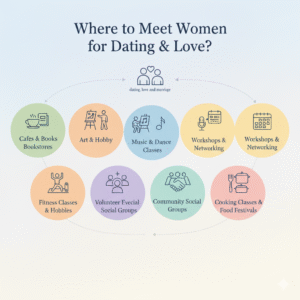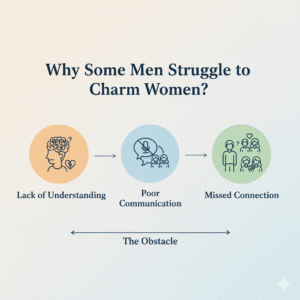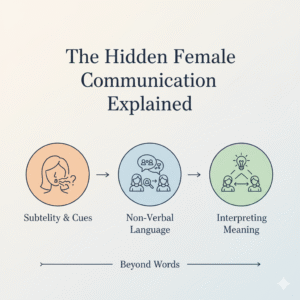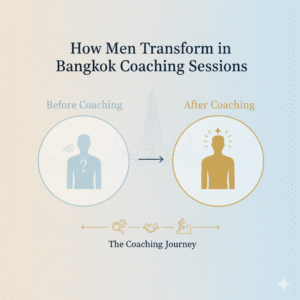Note: There is a podcast version of the below transcript at the bottom of the page. Do listen to that also.
One of the most common challenges Pratik hears from clients is this:
“I don’t know what to say.”
“What should I talk about?”
This is a tricky area–because verbal communication isn’t one-size-fits-all. It’s subjective, fluid, and influenced by a dozen variables in the moment.
Think about it:
How many times have you found yourself seated next to a beautiful woman–in a bar, on a flight, or at a café–wanting to strike up a conversation, but drawing a blank?
Chances are, it’s happened more than once.
And when you reflect back on those moments, the most common reason for hesitation sounds like:
“I just didn’t know what to say.”
Or maybe you started a conversation, only to get stuck a few lines in–unsure how to continue, and make it lighthearted. The words stop flowing. It’s frustrating.
Before diving into the technical side of improving verbal skills, let’s first understand the deeper patterns Pratik has observed in his clients that often cause this communication block.
Common Mindset Patterns That Disrupt Verbal Flow:
1. Identity Tied to Outcome
They place their entire self-worth on whether the conversation “succeeds” or not–even before it begins.
2. Performance-Based Thinking
They approach the interaction like a performance–trying to impress, gain brownie points, and seek approval.
3. Intimidation by Attractiveness
They feel genuinely intimidated by women–especially attractive ones–causing anxiety and hesitation.
4. Underdeveloped Improvisation
The part of the brain that connects seemingly unrelated thoughts and responds creatively in real-time is underused or “unmassaged.”
5. Lack of Enjoyment
They don’t genuinely enjoy the act of conversing–they see it as a task, not a dance.
6. Lack of Vocabulary
Sometimes it is difficult to find words, when you are made up of less words. Lack of vocabulary certainly holds you back from freely and confidently express oneself.
7. A weak reality of oneself
A weak reality of oneself means you are unsure of your expression in social dynamics. You are too concerned of how you will land with woman and the possible reaction.
Now that we’ve identified the seven most common patterns that cause you to go blank or freeze up during interactions, let’s shift gears and explore the technical nuances of verbal communication.
But before we dive in, keep this in mind:
Breaking these seven patterns takes time–and Pratik will guide you through it step by step.
⚠️ A Word of Caution on Verbal Communication Techniques
Pratik advises you not to get too deep into the theoretical nitty-gritty of verbal communication.
Trying to memorize concepts like:
Hook points
Frames
Screening and qualifying
Small talk
Storytelling
might turn you into a mechanical robot, stuck in your own head.
In real-life interactions–especially in Indian social settings–this overly technical approach can backfire.
Instead, what you truly need is:
Presence
Spontaneity
And a strong sense of relality.
💡 Why This Matters – An Indian Context
Let’s be real. When you’re trying to start a conversation with a woman without any context, it’s quite possible you’ll hit a wall.
Take this common scenario:
You (in an elevator): “Hi, how was your day?”
Her: “Good.”
(No follow-up. No return question. No elaboration.)
Now you’re left hanging, not knowing how to continue.
This is where presence kicks in. You need to pause, observe, and process her response–rather than rush into the next line.
🎯 Real Example from Pratik
Pratik once met a female pilot in an airport elevator. He casually asked, “How was your day?”
She replied, “Good”–but her tone carried exhaustion.
He paused, picked up on her emotional cue, and said:
“I feel like your other days are much better.”
She instantly smiled and replied:
“That’s so true… blah blah…”
She opened up. The interaction flowed naturally.
No technique. Just awareness.
🤔 Why a Woman Might Respond Briefly:
There are countless reasons why she may give a one-word answer:
She might be tired.
She could be shy.
She may be avoiding male attention.
She might come from a legacy family with rigid norms.
She could lack confidence or emotional bandwidth.
Or maybe… she’s testing your composure.
This is exactly why there’s no one-size-fits-all script.
You must learn to read her energy, not just her words.
🧠 But… Good Framing Still Helps
That said, developing an ear for good phrasing does help.
And one of the best ways to cultivate this is by reading fiction–especially rom-coms.
Why?
Because they immerse you in the rhythm of casual, playful, and emotionally rich conversations.
You get accustomed to how characters banter, tease, flirt, and connect–which is gold for real-world conversations.
Let me now share an example that’ll bring this to life…
Young Man:
“Good morning. I was talking kind of loud there. Sorry.”
Susan:
“Not at all. It was fascinating.”
Young Man:
“Oh yeah? What was ‘fascinating’ about it?”
Susan:
“You and ‘Honey’?”
Young Man:
“My kid sister. She just broke up with her boyfriend and she’s thinking about dropping out of law school.”
Susan:
“I’m sorry.”
Young Man:
“Nothing to be sorry about. That’s the way with men and women, isn’t it?”
Susan:
“What’s the way?”
Young Man:
“Nothing lasts.”
Susan:
“I agree.”
Young Man:
“Why?”
Susan:
“I was just being agreeable. Now I’ve got to explain why?”
Young Man:
“I’m not trying to sharpshoot you, but that ‘nothing lasts’ stuff, that’s what was the trouble with Honey’s guy. He was fooling around and Honey caught him at it. One girlfriend wasn’t enough for him.”
Susan:
“So you’re a one-girl guy?”
Young Man:
“Damn right. Looking for her right now. Who knows? You might be her.”
Susan:
(laughs)
So if Pratik would be reading this, he would picked out some lighthearted words and phrases from the above chat, and keep in his memory.
Like, “Being agreeable”, “One girl guy”
Pratik has observed that whenever his clients get tongue-tied in conversations, it usually stems from the seven core patterns discussed earlier.
The Quickest Way to Break This?
Practice slowing down–especially during the conversation.
And you don’t have to wait for a date or a high-stakes interaction to do this. Practice it in everyday settings–with friends, colleagues, waiters, or family members.
How to Practice Slowing Down
Set aside specific situations where you can consciously implement this–
for example, when you visit a restaurant.
You’ll naturally interact with the receptionist, the manager, or the server. During these interactions:
→ Listen fully.
→ Wait two full seconds after they finish speaking.
→ Then respond.
This exercise isn’t about being robotic–it’s about getting used to not rushing in during conversations.
That said, don’t apply this all the time. In most interactions, stay in your default flow. The goal is to train your brain to pause when needed–not to become mechanical.
Why We Rush
Most of us aren’t rushing in speech–but rushing in our own heads.
That mental race interrupts your flow and makes you go blank.
Let’s return to the most common of the seven patterns:
The Performance-Based Mindset.
Indian men are often conditioned to believe that they need to “win a girl over.”
As a result, they carry an internal map–“What to do to win her” and “What not to do to lose her.”
Take one of Pratik’s clients, for example.
He’d constantly freeze up in conversations because he was overly concerned about not sounding like an interviewer.
He was trapped in his mental map, afraid that one wrong move would spoil his chances of “winning.”
The Sustainable Fix: Self-Talk
Instead of trying to perfect every line, shift your internal dialogue.
In that client’s case, the self-talk could be:
“I need to first slow down in my head during the conversation. Forget the map. Even if it comes out a bit interview-like, that’s okay. My focus is on staying present and not rushing in.”
As for the Other Patterns?
They’ll naturally break down over time–with the right kind of social exposure.
And that doesn’t mean random socializing. It has to be curated and purposeful.






Leave a Reply